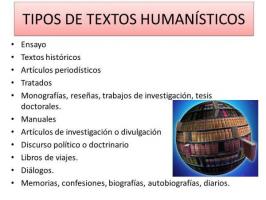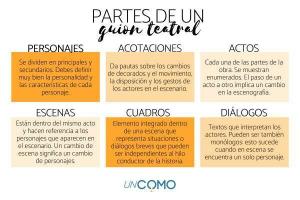LITERARY text types and characteristics
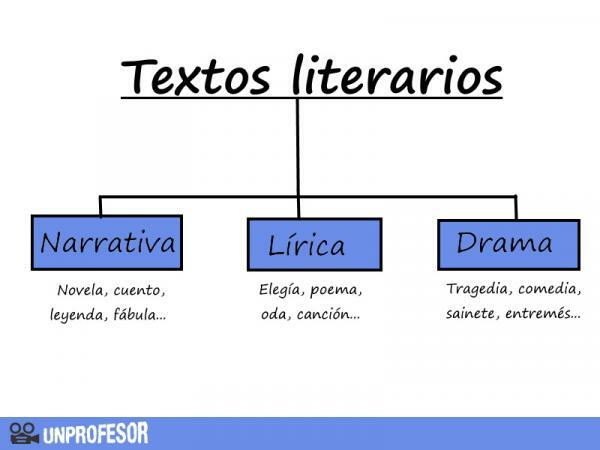
When we open a book, the text that we find inside can be of many types and, within the world of fiction and art, we find literary texts. But, in addition, there are many subtypes of literary texts that vary according to their use of language, their style, their uses, and so on. There are generally 3 types of literary texts: the narratives, the lyrical and the dramatic and, within them, there are different genres that are followed to better classify our literature. In this lesson from a TEACHER we are going to show you the types of literary texts and their characteristics so that you learn to detect them and you can know the vast variety that exists in the field of literature.
Index
- What is a literary text
- What are the characteristics of the literary text?
- Narrative texts
- Lyrical texts
- Dramatic texts
- Differences between literary text and non-literary text
What is a literary text.
Before analyzing the different types of literary texts, it is important that we clearly understand Concise what this textual typology consists of so that you know its definition and characteristics more featured.
A literary text is a text that fulfill a aesthetic and expressive function (Unlike those that are not literary that are used to give information or expose an idea to the reader). The purpose of these texts is artistic and, therefore, it is committed to offering a refined, careful and expressive that not only communicates, but also creates beautiful messages, sound phrases or images loaded with force.
The Author is in charge of giving the poetic force to his text, therefore, we are before works that are of subjective character and that they are contingent on the creation of a writer.
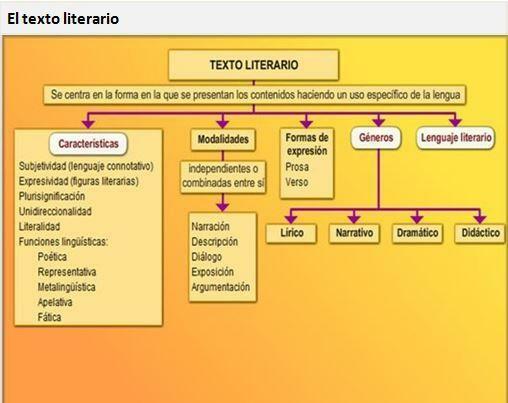
What are the characteristics of the literary text?
Features of literary texts
The main characteristics of literary texts and that, therefore, differentiate them from non-literary texts are the following:
- Poetic function: We have already commented that these texts serve an artistic and aesthetic purpose. In this case, the words are the tools of the artists and they work them so that they have a greater poetic and expressive meaning.
- Subjective: these texts present the particular vision of the author
- Clean language and style to give a more aesthetic and careful depth to the texts
- Fiction: the texts are fictional, therefore, imagined by the author. There may be characters or events inspired by reality, but the basis is fiction.
- Verisimilitude: for a literary text to work, it must be credible and, therefore, the stories must respect the principle of verisimilitude that is essential for this type of text
Narrative texts.
To know the different types of literary texts that exist, you should know that they are grouped into three big blocks:
- Narrative texts
- Lyrical texts
- Dramatic texts
We will start with the first of them all, the Narrative texts. As its name suggests, these texts have the figure of a storyteller who is in charge of telling us the story; The narrator can be in the first person, he can be a witness (he tells what he has heard or what he has been told) or in the third person or omniscient in which the narrator acts as if he were a God. Appear different characters located in a specific time and space and there is a main action which is what defines the plot of the story.
These texts usually have a structure Very detailed in which it begins with an introduction or approach, continues with the knot and ends with a denouement.
Narrative genres
There are different types of narrative texts that are differentiated by their gender. Here we leave you a summary with the most common genres within the narration:
- Epic: they are texts that were cultivated especially in antiquity and in which the heroic stories of characters that could be real or mythical were told. They are written in verse and a clear example of this is Homer's Iliad.
- epic poem: even if it is in verse, we are also faced with a narrative text because we are told a story, with a fixed structure and with characters and a detailed action. The epic poems explained to us a narrative of a hero who had existed in reality and who was an example to follow. These poems are the continuation of the epic and in Spain they are also known as "songs of gestto".
- Romance: within the category of "romance" are included different literary texts such as chivalric novels, the pastoralists, the byzantine and the sentimental.
- Fable: they are short stories that are usually directed to a child audience and that are led by non-human beings (animals, plants, objects, etc.). They have a final moral with didactic motivation.
- Epistle: without narrations that are presented in the form of a letter and that was very popular in the history of literature. They used to be written in verse but, nowadays, it is more common to find them in the form of a novel (epistolary novel) in which through the exchange of letters we know a story.
- Legend: another of the types of literary texts within the category of narrative are legends. In these texts we are told the heroic story of a character who embodies the ideal of citizen. They have supernatural and extraordinary elements that give the stories a more literary and mystical air.
- Story: they are short stories that tell us a story played by few characters and that focus on a single action. They are written in prose and can be intended for child or adult readers.
- Novel: it is the most modern version within the field of narrative. They are texts that, in general, are long and are written in prose. Due to their length, these narratives feature many characters and can have both plots and subplots.
Lyrical texts.
We continue to analyze the different types of literary texts that exist to talk about The lyric. In these texts we find that the author has a clear objective: Express feelings. There is usually a narrator who is in charge of explaining emotions, but other characters can also intervene.
The lyric is usually expressed in verse and therefore style, loudness, rhyme and meter are of great importance. In these texts, the use of literary resourcesIt is very constant, since with them it is possible to give greater strength and style to the language used.
Lyrical genres
Next we are going to talk about the Different genres what's inside the lyric so that you know the different ways in which this type of literary text has been cultivated:
- Ode: they are texts that are written with the aim of being sung and that have a sublime character
- Anthem: they were also written to be sung and had a celebratory purpose
- Elegy: they are literary texts that were cultivated in case of loss or death.
- Eclogue: it is a type of lyrical text that shows us an idealized reality and where the protagonists are shepherds. They were idealized texts and the most important work is "The Eclogues" by Virgilio.
- Satire: they are lyrical texts that were written with the aim of ridiculing a character, a society, and so on. Quevedo was the greatest exponent of this genre during the Baroque.
- Song: it is another genre within the lyric that usually has a love theme and that is written to be sung and accompanied by a musical instrument.
- Epigram: they are short texts that, currently, are used to write the epitaph of the tombs although, in the past, they could be satirical, educational, etc.

Dramatic texts.
And we conclude this lesson on the types of literary texts to talk about the dramaor, in other words, of the theater. These texts are characterized because they are written that are presented as dialogues and that have a more direct and less descriptive tone.
Dramatic texts have elements that are typical of this typology such as, they are, the division of the plot by acts and, in turn, by scenes. Each scene by itself has a presentation-middle-end structure and is included in the rest of the text to explain the history of its protagonists.
Another important point is that dramatic texts also have annotations of the playwright in which aspects relating to the stage, the actions, etc. are indicated.
Dramatic genres
Within drama or theater we also find very diverse genres that are the following:
- Tragedy: these are the texts from Ancient Greece that tell us a story starring heroic characters and that have a tragic ending. They were texts that wanted to give lessons on morality and civics, as well as instruct the population about the myths of the culture.
- ComedyComedy is another type of theatrical text that has a happy ending and a more fun and entertaining tone. It has characters that may be exaggerated to achieve this comic goal.
- Tragicomedy: it is a genre that unites the two genres of comedy and tragedy, achieving a surprising result.
- Melodrama: It is a genre that is characteristic of the nineteenth century in which musical intermediates are incorporated. It was a fun and festive kind of play.
- Sainete: they are short pieces that can be in verse or prose and that focus on giving a humorous and satirical touch to everyday life.

Differences between literary text and non-literary text.
Now that you know the different types of literary texts, let's delve into a topic that causes a lot of confusion among students: what are the differences between a literary text and a non-literary text?
Basically, both types of texts are distinguished by a specific element: the type of use of the text.
- That is, a literary text It is written with the intention of entertain, to communicate a subjective world, ideas, tell a story, and so on. It is a text that is included within the artistic world. An example of a literary text is a novel, a play, a poem...
- Instead, a non-literary text is a type of text that is written with a clear objective: communicate an idea or concept. They are texts that use language with the mere will to communicate, without including literary resources that beautify or create striking images. A non-literary text is, for example, a newspaper news, an instruction manual, the political program of a match, and so on.
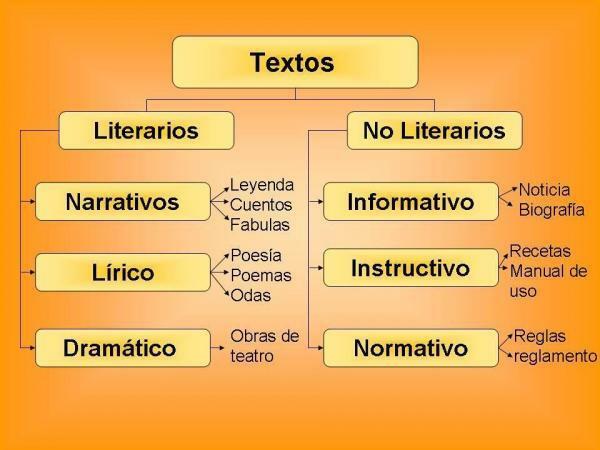
If you want to read more articles similar to Types of literary texts and characteristics, we recommend that you enter our category of Literary concepts.
Bibliography
- From Rivarola, S. R. (1979). Fictionality, reference, types of literary fiction. Lexis, 3 (2), 99-170.
- Mendoza, N. (2007). The types of texts in Spanish: forms, technique and production.

